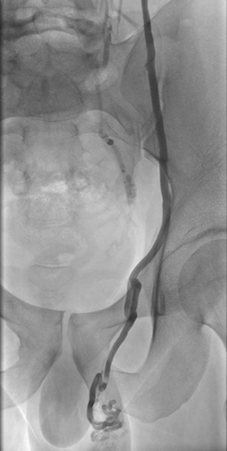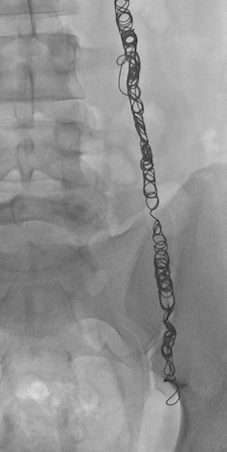What is a varicocele?
A varicocele is a network bunch of enlarged veins in the scrotum, which may make it look and feel like a "bag full of worms". Varicoceles may be asymptomatic. However in certain patients, varicoceles may cause discomfort, testicular atrophy (shrinkage) and my contribute to infertility.
What causes a varicocele?
Veins are reliant on valves in order to return blood to the heart. The left testicular vein normally arises from the left kidney. If the valves are not present or are incompetent (leaky), blood will flow back from the kidney to the left testis. Over time, these veins adjacent to the testis will become engorged and enlarged.
What is embolization?
Embolization is a common endovascular technique, employed by Interventional Radiologists. It is a technique designed to occlude blood vessels. A thin catheter is introduced to the venous system, either at the top of the leg, or above the collar bone. The skin is not cut, and so this should not mark the skin. The catheter is less than 1mm in diameter and is navigated to the vein to the left kidney and thence into the testicular vein under high resolution xray guidance. The testes will not be in the xray field.
The vein is then blocked/occluded with fibered filaments called coils. These are made from platinum or stainless steel. A sclerosant may also be injected in order to aid occlusion of the vein. These techniques will prevent venous reflux to the testis.
The procedure is normally performed in a day-surgery setting. It is performed with light sedation and local anaesthetic. The procedure itself takes approximately 30 minutes. Most patients go home after a short recovery time of around 2 hours.
Update - Since January 2015 Dr Steinfort has been treating this condition via an upper right arm incision. The incision point is still only 2mm, and the approach by the arm is even more comfortable, and less conspicuous.
How does blood drain from the testes?
When the testicular vein is blocked, the testis is drained toward the heart by alternative or “collateral” channels. The diseased testicular vein does not drain the testis. These multiple collateral channels have formed as a result. These are small channels and do not allow reversal of flow which was the underlying cause of the varicicoele.
How effective is embolization
The success rate for curing the variciocoele is above 90% for embolization.
What should I do afterwards?
You need to arrange transport as you are not allowed to drive after the sedation. On the day of the procedure, do not engage in vigorous activity and maintain good hydration. Normal activity can be resumed the following day except that you should avoid strenuous physical activity for 5 days. Mild abdominal and back discomfort may be experienced for up to 7 days – it is not normally severe. The variciocoele should resolve after about 6 weeks. You should also see your urologist for further follow-up. Sperm count can be performed after three months.
Because these are treated by endovascular techniques, recovery is minimal. In contrast to open surgery, there are no cuts made into the skin and a general anaesthetic is not required.
Are there any complications with embolization?
Minor complications although uncommon may occur such as bruising at the entry site, mild back ache and nausea. Transient swelling and pain of the scrotum may occur. All of these symptoms normally resolve within a week. Migration of coils in the lungs is exceptionally rare and usually has no significant consequence.


For more information about varicoceles visit the following website: Varicoceles.com


